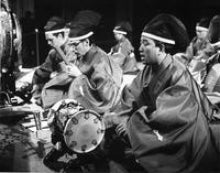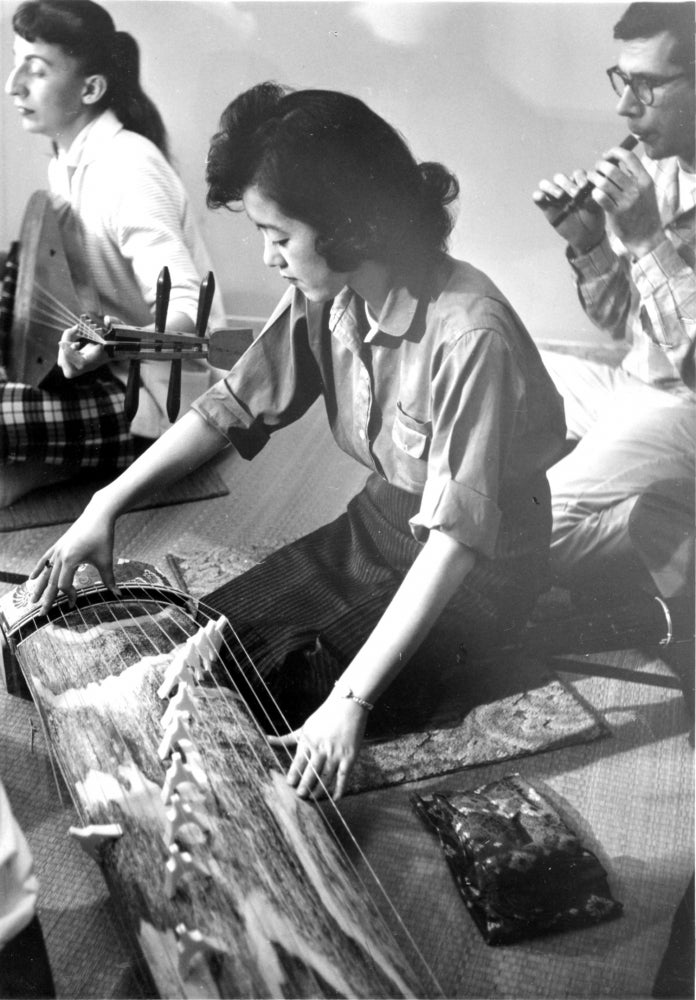Highlights from the Ethnomusicology Archive: Music of Japan

The Music of Japan ensemble began in 1956 as a gagaku group led by then-graduate student Robert Garfias.
For those unfamiliar with Professor Garfias, he researched gagaku for both his master's thesis and his doctoral dissertation. The focus of his research was a study of the living contemporary practice of gagaku in the Japanese Imperial Palace and to trace, from historical documents, the patterns of change which occurred during the 900 years of its practice in Japan. Garfias' thesis (1958) was entitled "The Basic melody of the Tōgaku pieces of the Gagaku repertoire." Garfias' dissertation (1965) was entitled "The Tōgaku style of Japanese court music; an analysis of theory in practice." A version of his dissertation entitled "Music of a thousand autumns: the Tōgaku style of Japanese court music" was released as a book by the University of California Press in 1975.
During his academic career Garfias founded the ethnomusicology program at the University of Washington, served as Dean of the School of Fine Arts at the University of California, Irvine, and conducted significant periods of fieldwork and language study around the world, including in Japan, Korea, Burma, Okinawa, the Philippines, Mexico, Central America, Zimbabwe, Romania, Turkey, and Spain. Garfias was appointed to the National Council on the Arts of the National Endowment for the Arts and also the Smithsonian Council. He served as a senior research fellow for the Japanese National Museum of Ethnology in Senri (Osaka), Japan. In 2005 the Government of Japan awarded Robert Garfias with the Order of the Rising Sun, Gold Rays with Neck Ribbon, for his contributions to promoting traditional Japanese culture and cultural exchanges between Japan and the United States.

Japan's Order of the Rising Sun, Gold Rays with Neck Ribbon. Photo courtesy of Robert Garfias.
Professor Garfias shared this memory of the gagaku ensemble with us. "One of the famous members of the 1958 Gagaku ensemble was Frank Gehry. He reminded me of this years later, and told me that he had designed Disney Hall with the idea of hearing Gagaku played there. In 2004, he and I worked together to bring Gagaku to Disney Hall."
To learn more about their collaboration, read "Disney Hall Holds Court," in the 14 October 2004 edition of the Los Angeles Times.

Cover of Gagaku: The Music and Dance of the Japanese Imperial Household by Robert Garfias (New York: Theatre Arts Books, 1959)
This booklet, Gagaku: Music and Dance of the Japanese Imperial Household, was the program booklet for the 1959 US tour of the Japanese court musicians. Garfias toured with them as an interpreter. They performed three nights at UCLA, where Garfias gave the introductory lecture each night.
In May 1960, the Music of Japan ensemble performed in the "Festival of Oriental Music and the Related Arts." Produced by Mantle Hood, this event, now called the Spring Festival of World Music, has taken place annually ever since.

Festival brochure
In the early 1960s, the gagaku group was directed by UCLA Music Librarian Gordon Stone and the nagauta group was directed by William Malm, with Joyce Malm as dancer.
These groups remained extra-curricular “study groups” until 1964-1965 when Music 45G/145G: Music of Japan was offered for the first time. Instructors of the Music of Japan Ensemble included: Robert Garfias, Suenobu Togi (1962-1993), Mitsuru Yuge (1962-1989), Ikuko Yuge (1962-2001) and Bill Shozan Schultz (1995-2001).

Gagaku Ensemble, includes Max Harrell, Gordon Stone, Ikuko Yuge, and Mitsuru Yuge

Gagaku Ensemble, includes Donn Borcherdt, Max Harrell and Ikuko Yuge

Ikuko Yuge playing the koto in the Gagaku Ensemble

Mitsuru Yuge playing shakuhachi

Suenobu Togi performing a Bugaku dance
Read this article by Paul J. Revitt in the 1961 issue of College Music Symposium, the journal of The College Music Society, to get a taste of the UCLA Institute of Ethnomusicology in 1961.
To quote Revitt, "Under the directorship of Suenobu Togi, Court Musician of the Imperial Household of Japan, even the facial expressions and the stylized gestures in holding and playing any of the instruments in this ensemble are of serious concern. Since gagaku is the most austere form of Japanese music, retaining courtly and Shinto traditions over a thousand years old, it is little wonder that even the rehearsals are special occasions bordering on the mysterious."
For those unfamiliar with Gagaku, watch Gagaku: The Court Music of Japan. Hosted by William Malm, it also features Suenobu Togi. (I'm sure many of you will recognize UCLA's Schoenberg Music Building and Dickson Court South.)
Gagaku: The Court Music of Japan. Hosted by William Malm, featuring Suenobu Togi
To learn more about the UCLA Music of Japan Ensemble...
Garfias Reflections and Reminisces on Stravinsky, Leonard Berstein, and Gagaku
SEM biography of Robert Garfias
DANCE: AMERICAN GROUP PERFORMS JAPANESE GAGAKU in the New York Times, 25 December 1982, to quote "Educated at the Imperial Court Music School and one in a long line of Gagaku performers, Mr. Togi has worked with the Study Group, founded in 1956, and his students there were invited to perform Gagaku in Japan last year, the first Americans to do so."
UCLA Gagaku Ensemble Blessing Lays Foundation For Art Dealer`s Condo in the Chicago Tribune, 28 January 1990
UCLA To Be A Place Of Courtly Elegance in the Los Angeles Times, 22 May 1986
Spring Concert of Japanese Traditional Music and Dance 29 April 2000. To quote: "Mr. Suenobu Togi of the Imperial Household came to UCLA in 1968 to teach Gagaku to American students. He returned to Japan in 1995 but his UCLA Gagaku group continue his legacy under the guidance of Ms. Ikuko Yuge. The UCLA Gagaku and Bugaku group is the only group outside of Japan and in the past had been invited to perform in Japan and China. The group will perform a dance and music including a lecture demonstration on Gagaku."
All photos (unless otherwise noted) © The Regents of the University of California, All Right Reserved, various dates





